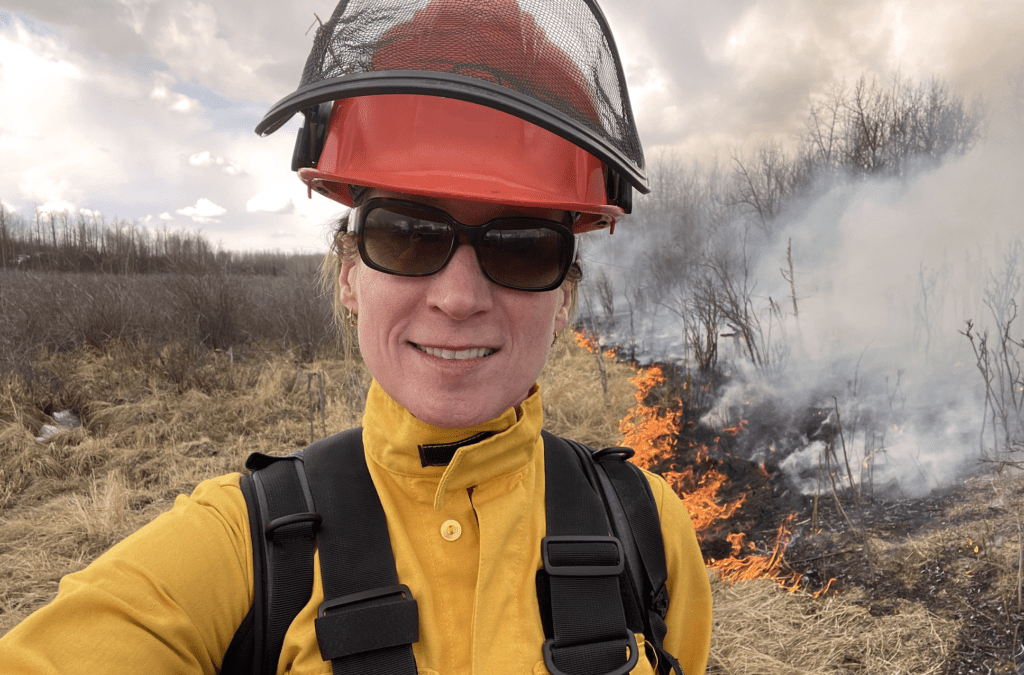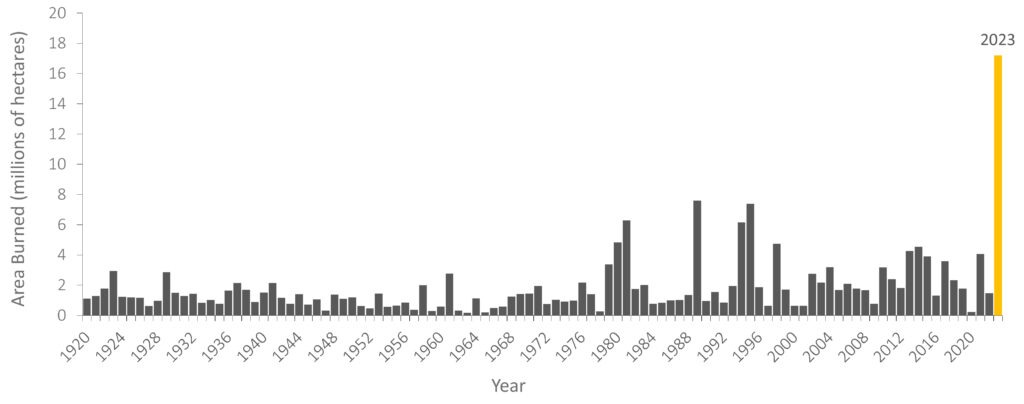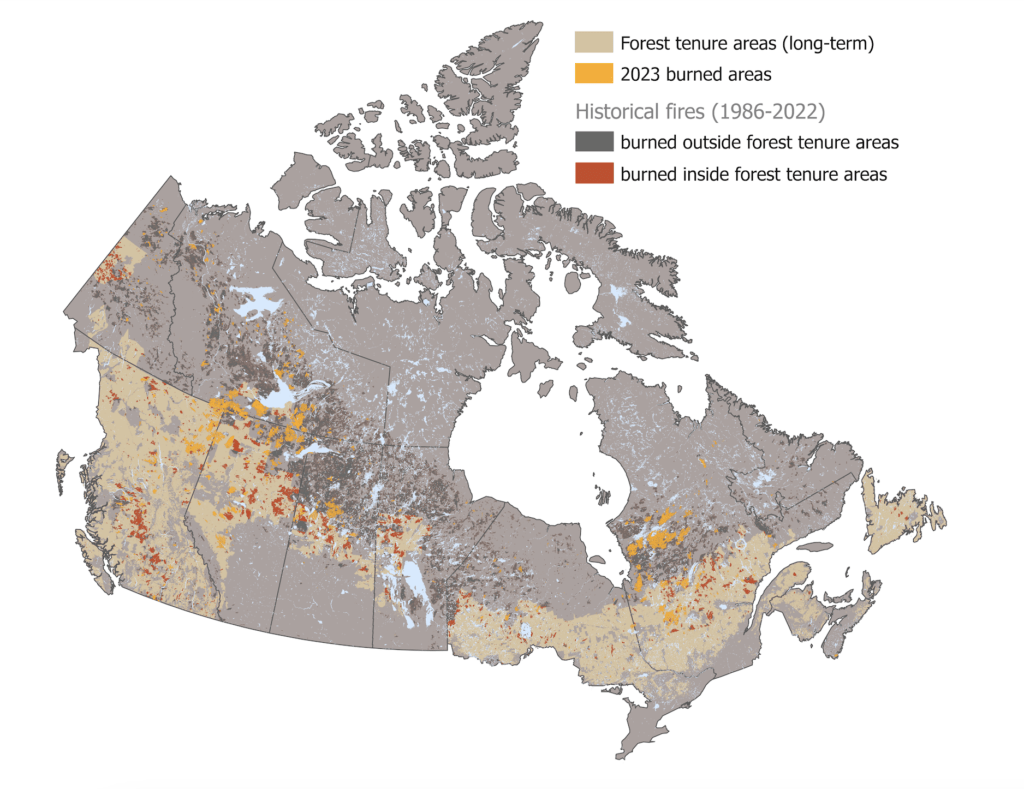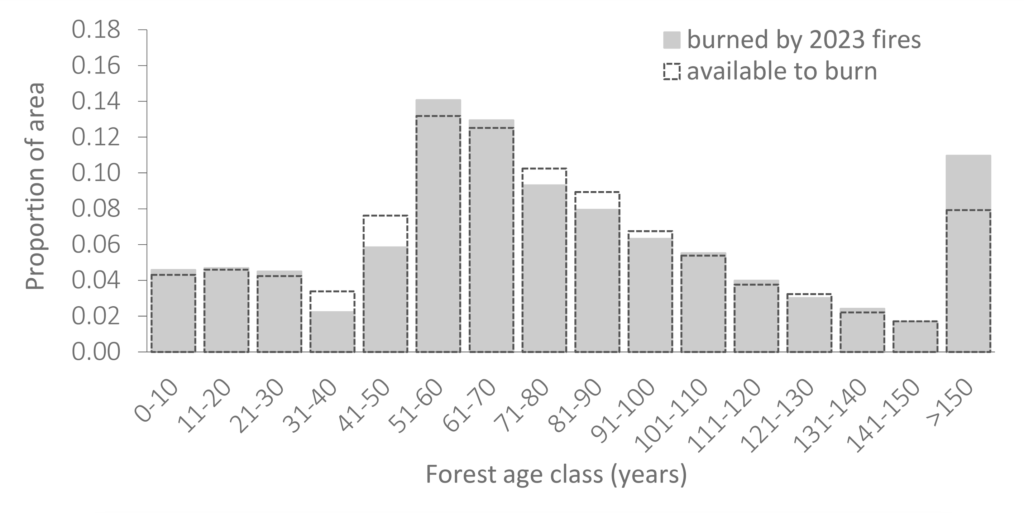Rethinking Fire Risk and Forest Management
 ‘There is no one-size-fits-all approach to mitigating wildfire risk across Canada’s diverse landscape,’ writes wildfire expert Dr. Jennifer Beverly.
‘There is no one-size-fits-all approach to mitigating wildfire risk across Canada’s diverse landscape,’ writes wildfire expert Dr. Jennifer Beverly.
By Dr. Jennifer L. Beverly
September 16, 2024
Canada’s severe 2023 fire season motivated many to pause and re-evaluate our understanding of wildfire risk, its underlying drivers, and the actions needed to ensure healthy and resilient socio-ecological systems into the future. In 2023, the area burned by wildfires in Canada was roughly 15 to 17 million hectares, presenting as a distinct outlier (Fig. 1).
Extreme fluctuations in national burned area from year to year are not unusual. Previous extreme years burned areas exceeding six million hectares in 1981, 1989, 1994 and 1995. Notably, the area burned in 1981 was five times the average observed in preceding decades – a relative increase not dissimilar to 2023. But on an absolute basis, the scope of area burned in 2023 remains unprecedented during the past century.
 Figure 1. Annual area burned in Canada 1920-2023 (Source: National Fire Database, National Burned Area Composite, Canadian Interagency Forest Fire Centre).
Figure 1. Annual area burned in Canada 1920-2023 (Source: National Fire Database, National Burned Area Composite, Canadian Interagency Forest Fire Centre).
Despite decades of investment in research and modeling to predict fire activity into the future, and under a warming climate, no study, no model and no wildfire expert in the country predicted wildfires could burn over 15 million hectares in Canada in a single year – and yet, it happened. The obvious conclusion is that we should not be relying on the data, research methods, and management practices of the past to effectively anticipate and manage wildfire in the years ahead.
An entrenched legacy of fire research and fire management ideologies that support a fire suppression mandate is a major constraint in conceptualizing and addressing fire risks. The system developed in Canada to rate the risk of wildfires was designed to help fire management agencies anticipate where and when fires could ignite and what those ignited fires could do over the course of metres and hours, all based on daily ratings of fuel moisture, potential fire behaviour, and associated predictions of fire characteristics such as intensity and rate of spread.
In recent decades, increased fire activity and impacts on socio-ecological systems have shifted the emphasis away from fire suppression and towards wildfire mitigation. This has elevated fire risk from a day-to-day consideration exclusive to operational fire response staff who manage individual fire events, to a strategic-level consideration extending several years into the future and covering large regions over which mitigation efforts must be proactively planned and implemented by a suite of decision makers with diverse perspectives and needs.
Early efforts by federal government fire researchers to supply strategic wildfire risk assessments did so by repurposing the same models that were already in place for informing fire response operations. Advances in computing technology in the early 2000s made it possible to use those existing models in ways they were never designed for. For example, complex simulations meant thousands of fires could be grown across a computer landscape to map areas that burned most often. The resulting burn probability maps were promoted as a guide for mitigation action such as fuel reduction treatments. But more recently, studies in Alberta and Alaska have shown that real fires don’t tend to burn in the hotspots of these simulated burn probability maps.
Alternative approaches for informing fire risk, such as landscape fire exposure assessments, show better alignment with real wildfires, but only due to a radical departure from the ideologies of the past. Instead of attempting to model all of the factors that dictate when, where and how fires burn (i.e., fuel, weather, topography and ignitions), these new assessments focus exclusively on the one thing we can know with any degree of certainty: the fuel hazard.
We must accept that there is no one-size-fits-all approach to mitigating wildfire risk across Canada’s diverse landscape.
An emphasis on fuels alone recognizes just how unpredictable fires are over the longer decision horizons necessary for mitigation planning. Every negative fire impact is the product of a perfect storm: an ignition falls on fuels that happen to be dry and receptive to that ignition, which happens to align with a wind direction that happens to push the ignited fire towards more fuel that happens to imperil something of value. In the aftermath of such a fire, it is relatively easy to explain how that specific confluence of factors generated the observed outcome, which gives a false sense of confidence in our ability to predict and avoid these events before they happen (i.e., hindsight bias).
In reality, we cannot predict where lightning will strike across a management area nor where a spark will fly from a chainsaw somewhere in the forest; nor can we predict which way the wind will be blowing when those serendipitous ignitions happen.
This kind of deeply uncertain future means that we cannot assign fire likelihoods or probabilities with any degree of confidence. This demands alternative, non-probabilistic approaches to strategic risk assessment, such as robust decision making and futures and foresight analysis. Robust approaches would involve a broad exploration of the decision space in fire and forest management, while futures studies provide tools to imagine the future beyond what is probable, to include plausible futures, possible futures, and desired futures as well. Unfortunately, efforts to guide wildfire science nationally tend to define risk within a traditional likelihood-times-impact probabilistic framework that is championed by many in government.
Regardless of how fire risk is assessed, the prescription for mitigation from a forest management perspective remains unclear. Severe fires and fire seasons in Canada are routinely attributed to fuel build-up caused by decades of fire suppression and forest mismanagement. This may indeed be the case in some regions of the country, but the extent to which fuel accumulation is broadly contributing to severe fire seasons across Canada’s entire forested land base is unconfirmed.
Between 1986 and 2023, only about one fifth of national burned area occurred within long-term forest tenure areas (Fig. 2). Suppression of fires beyond these areas is limited throughout much of Canada’s boreal zone due to the sparse population and lack of values. Within forest tenure areas, where fire suppression has occurred for an extended period, it is possible that stands that would normally experience regular, lower intensity surface fires, predominantly in British Columbia, could develop unnatural fuel loads that support more intense fires. In the vast boreal forest, where high-intensity, stand-replacing fires are perfectly natural, fire suppression is thought to disrupt the age-class mosaic, creating expansive continuous forests at an advanced development stage, potentially supporting unconstrained fire growth.
 Figure 2. Locations of 2023 fires and historical fires (1986-2022) in relation to Canada’s forest tenure areas (i.e., long-term tenure per Stinson et al. 2019).
Figure 2. Locations of 2023 fires and historical fires (1986-2022) in relation to Canada’s forest tenure areas (i.e., long-term tenure per Stinson et al. 2019).
If historical fire and forest mismanagement is contributing to severe fire seasons, we would expect to see older stands burning preferentially due to presumed fuel accumulation and increased forest continuity. But in 2023, wildfires burned stands of all ages within Canada’s managed forest, generally proportionate to their availability (Fig. 2, 3). There were some disproportionate burned areas in the very oldest forest age-class (>150 years), but that represents a small proportion (2.7%) of the area burned within long-term tenure areas last year.
 Figure 3. Forest ages burned by 2023 wildfires (gray bars) within forest tenure areas (i.e., long-term tenure per Stinson et al. 2019). Hollow dashed bars show the corresponding proportion of area available to burn. Burned areas are from the National Burned Area Composite; forest ages circa 2017 from Maltman et al. (2023)
Figure 3. Forest ages burned by 2023 wildfires (gray bars) within forest tenure areas (i.e., long-term tenure per Stinson et al. 2019). Hollow dashed bars show the corresponding proportion of area available to burn. Burned areas are from the National Burned Area Composite; forest ages circa 2017 from Maltman et al. (2023)
Nonetheless, there have been calls to redesign forest structure and composition to cool the forest in support of wildfire resilience. Fire-smart forest management involves strategically altering forest fuels across large areas to reduce fuel continuity using harvesting, prescribed fire, lower flammability fuel types and other potential disruptions to fire spread, such as roads. Despite being introduced over 20 years ago, the assumptions of landscape-scale fuel management in Canada’s forests have yet to be thoroughly verified in the real world. Climate warming further complicates our understanding of how, when, and where to effectively manage fuels across not only broad landscapes, but at targeted localized scales as well.
We must accept that there is no one-size-fits-all approach to mitigating wildfire risk across Canada’s diverse landscape. Efforts to force national standards, approaches and directions are likely to fail, especially when focused on status quo approaches and entrenched ideologies. Wildfire mitigation can and should look very different from place to place, even within a single jurisdiction or management area. What is needed is funding to support these decentralized planning processes and commitment to remove jurisdictional and policy barriers to implementing locally planned action.
The recent devastation in Jasper, Alberta, reminds us of the ever-present wildfire threat. Imaginative approaches to a wildfire resilient future will be essential for identifying what actions are needed, uncovering vulnerabilities, cultivating innovative solutions, and guiding forest management to help build a brighter tomorrow.
Dr. Jennifer L. Beverly is an associate professor in the Department of Renewable Resources at the University of Alberta and has been studying wildfires for more than 25 years.
